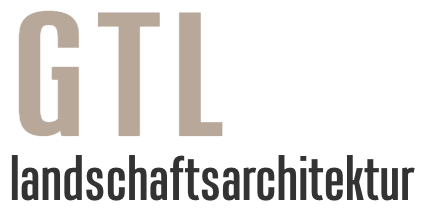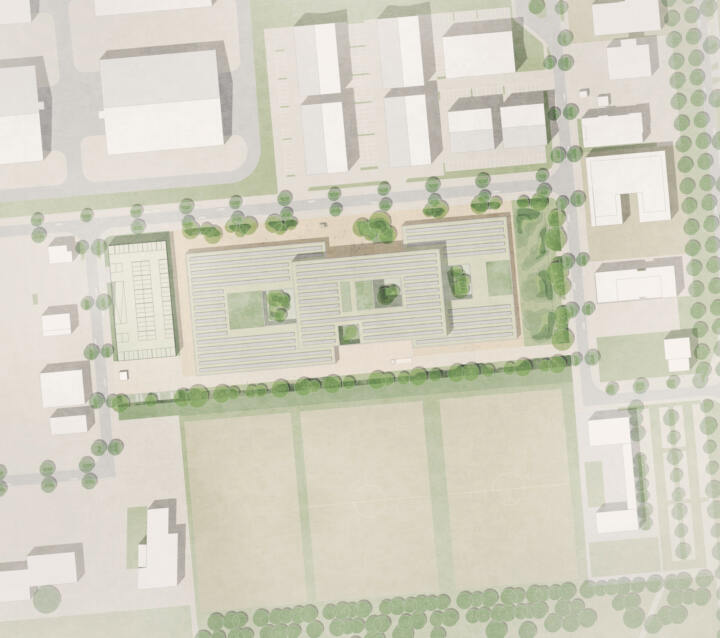10 | 2025 COMPETITION
Replacement building for the GGS - Strand Europaschule | Timmendorfer Strand
A third prize | In collaboration with Baufrösche Architects and Urban Planners
The new GGS Strand Europaschule combines a primary school and a community school in a clearly structured wooden building that combines educational diversity, sustainability, and spatial flexibility. The compact design creates a spacious open area that serves as a shared schoolyard and a diverse meeting place.
The outdoor facilities form a coherent learning and exercise landscape: from the green entrance area to the sheltered primary school playground with play equipment and green classroom to the large playground with groups of trees, seating areas, and play zones, a lively outdoor space for learning, playing, and community is created. Rainwater management, extensive green roofs, and species-rich planting areas promote biodiversity and create a sustainable microclimate. This makes the school a place that harmonizes architecture, environment, and education.
© Baufrösche Architekten und Stadtplaner, GTL
10 | 2025 COMPETITION
Wasserkuppe Arrival & Information Centre | Gersfeld (Rhön)
3rd prize | In collaboration with Sturm und Wartzeck
Basalt is the leitmotif of the design for the new information centre on the Wasserkuppe in Gersfeld. Like the multi-layered formations of the Rhön, the building responds to its surroundings with offset structures and differentiated edges. It connects the heterogeneous existing buildings with the open airfield and creates a central square in the northeast as the new centre of the area. To the south, the building opens up to the vastness of the landscape with terraces and viewing platforms.
The outdoor facilities also take up the basalt motif: staggered terraces follow the natural terrain and become spaces that can be experienced via steps and benches. Materials such as basalt, wood and golden accents create a harmonious unity of architecture and landscape. In the north, lush planting frames the event area, while in the south, an open green strip forms the transition to the gliding field.
© Sturm und Wartzeck, GTL
09 | 2025 COMPETITION
Former Telecommunications Office | Heusenstamm
1st prize | In collaboration with Thomas Schüler Architekten und Stadtplaner
The new urban quarter in Heusenstamm combines living with working and creates a sustainable environment with a high quality of open space. The central element is the Grüne Anger, a corridor with play, recreation and fitness areas under climate-resilient trees, supplemented by troughs for rainwater retention and biodiversity promotion. Green joints structure the building plots and facilitate orientation. The heart of the district is the neighbourhood square with fountains, play and event areas, framed by neighbourhood and multi-generational houses and a daycare centre, complemented by an entrance plaza with restaurants and neighbourhood amenities. Mobility is reorganised through neighbourhood garages and a mobility station with car sharing, rental bikes and e-charging stations, so that the inner area remains largely traffic-free. A three-stage rainwater concept and extensive greening strengthen climate resilience and the microclimate.
© Thomas Schüler Architekten und Stadtplaner, GTL
08 | 2025 COMPETITION
New construction of the Special Education Centre | Senden Neu-Ulm
1st prize | In collaboration with Atelier30
The outdoor facilities of the Special Education Centre in Senden form a diverse school landscape that blends gently into the topography and surroundings. The green forecourt with groups of trees and seating areas creates an inviting entrance. Break areas, green classrooms and a school garden open up a variety of outdoor learning spaces. Large-crowned trees, shrubbery and water-permeable surfaces combine quality of stay with ecological function: they promote biodiversity, store rainwater and improve the microclimate. To the south, a hedge of bird-friendly shrubs forms the transition to the agricultural landscape, complemented by species-rich meadows. Exercise facilities such as an all-weather playground, playing field and climbing wall expand the range of uses. A protected, natural play area is being created for the children's house with modelled terrain, edible plants and light deciduous trees that ensure a pleasant climate.
© Atelier30, GTL
07 | 2025 COMPETITION
New secondary school and sports hall Hafner | Konstanz
3rd prize | In collaboration with Atelier30
The new school grounds combine quality of life, exercise, learning and ecological sustainability. The day begins on the green forecourt with shady sweetgum trees and circular benches – an inviting meeting place with nearby bicycle parking spaces. The ‘school landscape’ is divided into green break areas, a quiet open-air classroom and biodiversity areas with meadows and bird protection plantings. Retention and infiltration areas improve rainwater management. The roof of the sports hall is transformed into an exercise landscape with calisthenics, obstacle courses, trampolines and grandstand furniture. A wide seating staircase leads to the streetball court and bouldering sculpture. All roof areas are designed as retention roofs with storage substrate and irrigation systems. Rainwater is also collected and used via terrain profiling, troughs and cisterns. Extensive planting specifically promotes biodiversity and creates species-rich, climate-resilient habitats.
© Atelier30, GTL
05 | 2025 COMPETITION
Transformation of the Helmstedt Mining Area | Helmstedt
Recognition | In collaboration with WELP von KLITZING
The Helmstedt mining area between Elm and Lappwald is being transformed into an innovative open-cast mine of the future. Instead of reconstructing past conditions, the area is understood as a historical document that tells its story. Natural processes and landscape changes are deliberately integrated. Targeted interventions create characteristic locations and strengthen unspoilt areas. The open-cast mining lakes are slowly filling up with groundwater and rainwater alone – a symbol of the cautious approach. Wind turbines, avenues and forest edges frame the area, making its dimensions visible and emphasising its value. A ring road (made up of the L244 and L245a) with colour-coded cycle paths emphasises the artificial enclosure. A finely meshed network of paths opens up the area for pedestrians and cyclists. Nature is reclaiming the territory – natural succession is creating diverse vegetation zones with a high level of biodiversity. This is turning the area into a special, near-natural experience space.
© WELP von KLITZING, GTL
03 | 2025 COMPETITION
Daycare Centre Hegge | Waltenhofen
2nd Prize | In collaboration with Benkert Schäfer
The daycare centre redefines the village centre and creates a common village square. Tree positions divide the new village centre into different areas of use. The daycare centre opens up as a house for children and offers space for communal uses in the community. The green open space of the daycare centre blends into the existing village structure. The preservation of valuable existing trees ensures that the outdoor facilities are shaded and creates a natural atmosphere. The terrain will be carefully modelled to create a varied play landscape. Targeted planting provides additional structure to the outdoor space and divides it into day nursery and crèche areas. Terrace-like open spaces create flowing transitions between indoor and outdoor areas. This creates a well thought-out combination of nature, play and community, which optimally supports the educational use of the outdoor space.
© Benkert Schäfer, GTL
02 | 2025 COMPETITION
New Construction of the Training Academy Chamber of Crafts Karlsruhe | Karlsruhe
Recognition | In collaboration with Atelier30
The new training academy building in Karlsruhe offers the Chamber of Crafts the opportunity to present itself as a modern learning and working environment. The building is functionally organised by staggering the structure. The main entrance is highlighted and leads to an entrance square that is connected to the multi-storey car park. This forecourt creates an attractive meeting point with its green spaces, shady trees and seating. In addition, inner courtyards offer space for relaxation as oases of peace and communication zones.
The open spaces rely on sustainable rainwater management, biodiversity-promoting plants and surfaces that can seep away. In addition, the building roofs will be intensively greened and parts of the façades will also be greened. The rainwater produced will be collected and used for the green spaces and building services, ultimately promoting sustainable urban development.
© Atelier30, GTL
01 | 2025 COMPETITION
Ferdinand-von-Steinbeis School | Tuttlingen
Recognition | In collaboration with Atelier30
The lively, green school campus is framed by the buildings and serves as a central hub. The open space concept supports an educational environment that is designed for collaborative learning, movement and communication. The versatile areas and seating options promote outdoor activities, encourage movement and provide space for collaborative learning and relaxation during breaks. The concept also takes various user needs into account and seamlessly integrates barrier-free access and disabled parking spaces into the design. Climate-related topics such as resilience, shading, extreme weather and retention are also taken into account here.
©Atelier30, GTL
12 | 2024 MULTIPLE COMMISSIONING
Fostfeld Centre | Kassel
2nd Prize | In collaboration with Baufrösche
The urban and open space planning designs for the development of the site of the former Heinrich Steul School were presented at a workshop meeting and further developed together with citizens in a cooperative and transparent process.
The design for the new Forstfeld district centre follows the guiding principle of ‘Forst in focus’. Three new buildings complement the existing Forstbachweg building and the gymnasium and together form the district centre. The future residential buildings, consisting of the ‘Tower’ and ‘Atrium House’, complement the ‘Boomerang House’, which creates space for meetings, education and living. The structural arrangement creates an open residential courtyard. A park-like open space serves as a connection between the elements and invites people to relax, play and exercise. The neighbourhood square facing Forstbachweg forms an entrance to the new district centre.
©Baufrösche, GTL











